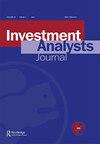The asymmetric relationship between volatility index and volatility-of-volatility index
IF 2.2
4区 经济学
Q3 BUSINESS, FINANCE
引用次数: 1
Abstract
ABSTRACT We use the nonlinear autoregressive distributed lag model to assess the asymmetric relationship between the Chicago Board Options Exchange’s volatility index (VIX) and volatility-of-volatility index (VVIX) over the period January 2007 to March 2020. To control for potentially confounding factors, we include measures for economic policy uncertainty and the volatility risk premium. There are three key findings. First, we find that there is an asymmetric long run cointegrating positive relationship running from VVIX to VIX. In this long run relationship, VIX is more responsive to deceases in VVIX than increases in VVIX. Second, we also find an asymmetric short run relationship between VIX and VVIX. However, in contrast to the long run results, for the short run VIX is more responsive to increases in VVIX than decreases in VVIX. Third, consistent with other studies, we find that in the long run VIX rises with greater economic policy uncertainty but falls with increases in the volatility risk premium. We discuss the implications of our findings for practitioners in risk and portfolio management, derivative pricing, and trading.波动率指数与波动率指数波动性的非对称关系
摘要本文采用非线性自回归分布滞后模型对2007年1月至2020年3月期间芝加哥期权交易所波动率指数(VIX)和波动率-波动率指数(VVIX)之间的不对称关系进行了评估。为了控制潜在的混淆因素,我们纳入了经济政策不确定性和波动性风险溢价的措施。有三个主要发现。首先,我们发现从VVIX到VIX之间存在不对称的长期协整正关系。在这种长期关系中,VIX对VIX的下降比VIX的上升更敏感。其次,我们还发现VIX和VVIX之间存在不对称的短期关系。然而,与长期结果相反,短期波动率指数对波动率指数上升的反应比对波动率指数下降的反应更灵敏。第三,与其他研究一致,我们发现在长期内,VIX随经济政策不确定性的增加而上升,但随波动率风险溢价的增加而下降。我们讨论了我们的研究结果对风险和投资组合管理、衍生品定价和交易从业者的影响。
本文章由计算机程序翻译,如有差异,请以英文原文为准。
求助全文
约1分钟内获得全文
求助全文
来源期刊

Investment Analysts Journal
BUSINESS, FINANCE-
CiteScore
1.90
自引率
11.10%
发文量
22
期刊介绍:
The Investment Analysts Journal is an international, peer-reviewed journal, publishing high-quality, original research three times a year. The journal publishes significant new research in finance and investments and seeks to establish a balance between theoretical and empirical studies. Papers written in any areas of finance, investment, accounting and economics will be considered for publication. All contributions are welcome but are subject to an objective selection procedure to ensure that published articles answer the criteria of scientific objectivity, importance and replicability. Readability and good writing style are important. No articles which have been published or are under review elsewhere will be considered. All submitted manuscripts are subject to initial appraisal by the Editor, and, if found suitable for further consideration, to peer review by independent, anonymous expert referees. All peer review is double blind and submission is via email. Accepted papers will then pass through originality checking software. The editors reserve the right to make the final decision with respect to publication.
 求助内容:
求助内容: 应助结果提醒方式:
应助结果提醒方式:


